TABLE A: OBSERVATIONS AND GROUPINGS
| S. No. | Group Members
(Names Of Organisms) |
Shared Features |
| 1 |
|
|
| 2 |
|
|
| 3 |
|
|
| 4 |
|
|
| 5 |
|
|
| 6 |
|
|
| 7 |
|
|
| 8 |
|
|
| 9 |
|
|
QUESTIONS
Question: 1
My formulated groups somehow match with other class fellows but not to a great extent. The reason behind a little resemblance between the groups formulated by different class fellows might be the difference of criteria. Every class fellow must have selected and observed the objects with a different perspective.
Question 2:
In fact, if we combine group 4, 5 and six, then we could have a larger group that could be further divided into subgroups. However because of limitation of provided table’s sections I have already split them and made three groups instead.
Question 3:
It is already mentioned in the answer number 2 that group 4.5 and six can be gathered as a bigger group. This amalgamation could take place on some basic features of the objects of these groups.
Question 4:
Fruitbat was a difficult object to be placed only in one group because it has wings and therefore it should belong to birds. Nevertheless, it mammary attributes make it more relevant to mammals’ group.
Question 5:
| Harder outer cover (but not shell) | Barnacle (group 4) Clam, snail (group 7) |
| Wings | Fruitbat (group 8)peregrine falcon, hummingbird (group 9), monarch (group 5) |
| Have more than four legs | Monarch (group 5) blue crab, barnacle (group 4),Tarantula, tick (group 6) |
Question: 6
Organisms that belong to different groups can be apart from each other but can have similar attributes because of the notion of convergent evolution. According to this phenomenon, ancestors of diverse organisms utilize analogous resources and encounter alike environmental factors. Therefore, such organism developed similar structures.
Question 7:
All twenty given objects of observation share some underlying attributes such as reproduction and adaptation to diverse environmental conditions as well as DNA as a hereditary factor.
IDENTITIES OF CARTOON ANIMALS IN SET “A”
| CARTOON ANIMALS | SCIENTIFIC NAMES |
| A1 | Rotundopedus Bipede |
| A2 | Octocrus Mirum |
| A3 | Palma Thyrsus |
| A4 | Chelicerus Stipula |
| A5 | Rotundopedus Unipede |
| A6 | Chelicerus Longacrus |
| A7 | Octocrus Archetypum |
| A8 | Palma Magnocauda |
QUESTIONS
Question: 7
A8 resembles most to A3 as they both share several characteristics and only their tail shape makes them different.
Question: 8
Yes, a whole diverse key could be developed to attain the similar results to identify all provided cartoon animals. The key can be reorganized to commence evaluation by implementing different attributes.
Question: 9
Good dichotomous key features clear description without implying any indistinctness. Such precise description makes it easy to distinguish the objects and to categorize into different types.
PART 2B – DICHOTOMOUS KEY
QUESTIONS
Question: 10
There are about six boxes in the dichotomous key developed above.
Question: 11
Yes, the chart can be made with a fewer or even with more steps and boxes.
Question: 12
It is better to have a fewer number of boxes because it helps to devise a solution in a faster manner and becomes simpler and easier to comprehend the implications.
Question: 13
As it is evident from the chart given above that B3 is more closely related to B1.
Question: 14
No, physical features not sufficient enough to determine such factors.
Question: 15
There are some other methods including evaluation of protein sequences as well as a comparison of DNA structure to identify the connectivity of two animals, people or aliens.
Work Cited
“Convergent Evolution.” ScienceDaily, ScienceDaily.
www.sceincedaily.com/terms/convergent_evolution.htm.






